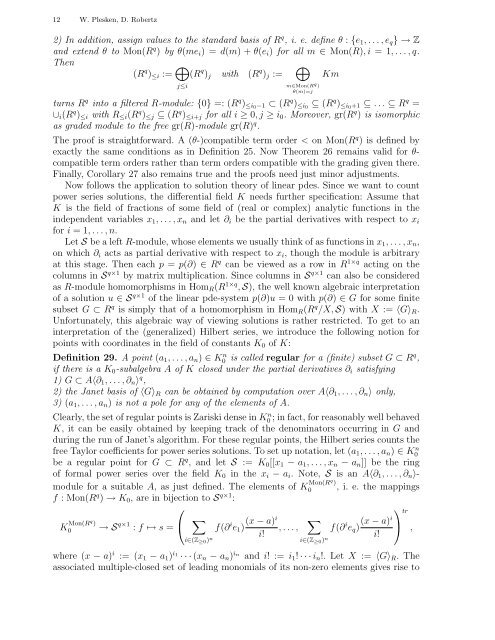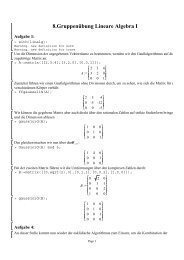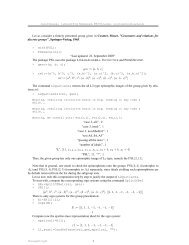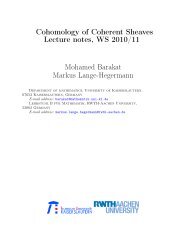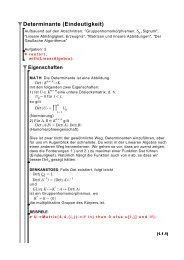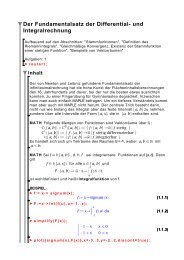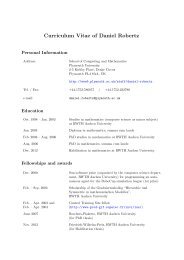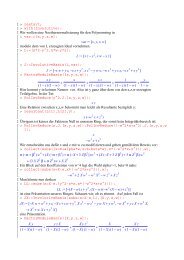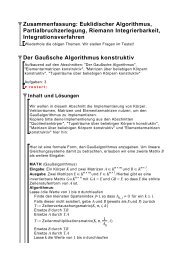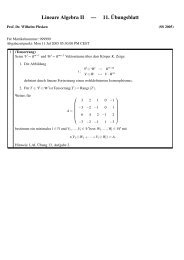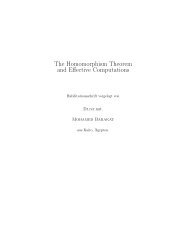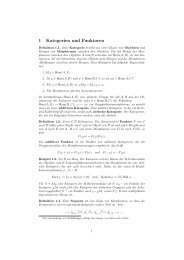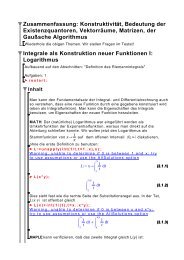Janet's approach to presentations and resolutions for polynomials ...
Janet's approach to presentations and resolutions for polynomials ...
Janet's approach to presentations and resolutions for polynomials ...
You also want an ePaper? Increase the reach of your titles
YUMPU automatically turns print PDFs into web optimized ePapers that Google loves.
12 W. Plesken, D. Robertz2) In addition, assign values <strong>to</strong> the st<strong>and</strong>ard basis of R q , i. e. define θ : {e 1 ,...,e q } → Z<strong>and</strong> extend θ <strong>to</strong> Mon(R q ) by θ(me i ) = d(m) + θ(e i ) <strong>for</strong> all m ∈ Mon(R),i = 1,...,q.Then(R q ) ≤i := ⊕ (R q ) j with (R q ) j := ⊕Kmj≤im∈Mon(R q )θ(m)=jturns R q in<strong>to</strong> a filtered R-module: {0} =: (R q ) ≤i0 −1 ⊂ (R q ) ≤i0 ⊆ (R q ) ≤i0 +1 ⊆ ... ⊆ R q =∪ i (R q ) ≤i with R ≤i (R q ) ≤j ⊆ (R q ) ≤i+j <strong>for</strong> all i ≥ 0,j ≥ i 0 . Moreover, gr(R q ) is isomorphicas graded module <strong>to</strong> the free gr(R)-module gr(R) q .The proof is straight<strong>for</strong>ward. A (θ-)compatible term order < on Mon(R q ) is defined byexactly the same conditions as in Definition 25. Now Theorem 26 remains valid <strong>for</strong> θ-compatible term orders rather than term orders compatible with the grading given there.Finally, Corollary 27 also remains true <strong>and</strong> the proofs need just minor adjustments.Now follows the application <strong>to</strong> solution theory of linear pdes. Since we want <strong>to</strong> countpower series solutions, the differential field K needs further specification: Assume thatK is the field of fractions of some field of (real or complex) analytic functions in theindependent variables x 1 ,...,x n <strong>and</strong> let ∂ i be the partial derivatives with respect <strong>to</strong> x i<strong>for</strong> i = 1,...,n.Let S be a left R-module, whose elements we usually think of as functions in x 1 ,...,x n ,on which ∂ i acts as partial derivative with respect <strong>to</strong> x i , though the module is arbitraryat this stage. Then each p = p(∂) ∈ R q can be viewed as a row in R 1×q acting on thecolumns in S q×1 by matrix multiplication. Since columns in S q×1 can also be consideredas R-module homomorphisms in Hom R (R 1×q , S), the well known algebraic interpretationof a solution u ∈ S q×1 of the linear pde-system p(∂)u = 0 with p(∂) ∈ G <strong>for</strong> some finitesubset G ⊂ R q is simply that of a homomorphism in Hom R (R q /X, S) with X := 〈G〉 R .Un<strong>for</strong>tunately, this algebraic way of viewing solutions is rather restricted. To get <strong>to</strong> aninterpretation of the (generalized) Hilbert series, we introduce the following notion <strong>for</strong>points with coordinates in the field of constants K 0 of K:Definition 29. A point (a 1 ,...,a n ) ∈ K n 0 is called regular <strong>for</strong> a (finite) subset G ⊂ R q ,if there is a K 0 -subalgebra A of K closed under the partial derivatives ∂ i satisfying1) G ⊂ A〈∂ 1 ,...,∂ n 〉 q ,2) the Janet basis of 〈G〉 R can be obtained by computation over A〈∂ 1 ,...,∂ n 〉 only,3) (a 1 ,...,a n ) is not a pole <strong>for</strong> any of the elements of A.Clearly, the set of regular points is Zariski dense in K0 n ; in fact, <strong>for</strong> reasonably well behavedK, it can be easily obtained by keeping track of the denomina<strong>to</strong>rs occurring in G <strong>and</strong>during the run of Janet’s algorithm. For these regular points, the Hilbert series counts thefree Taylor coefficients <strong>for</strong> power series solutions. To set up notation, let (a 1 ,...,a n ) ∈ K0nbe a regular point <strong>for</strong> G ⊂ R q , <strong>and</strong> let S := K 0 [[x 1 − a 1 ,...,x n − a n ]] be the ringof <strong>for</strong>mal power series over the field K 0 in the x i − a i . Note, S is an A〈∂ 1 ,...,∂ n 〉-module <strong>for</strong> a suitable A, as just defined. The elements of K Mon(Rq )0 , i. e. the mappingsf : Mon(R q ) → K 0 , are in bijection <strong>to</strong> S q×1 :⎛⎞K Mon(Rq )0 → S q×1 : f ↦→ s =⎝ ∑i∈(Z ≥0 ) n f(∂ i e 1 )(x − a)ii!,...,∑i∈(Z ≥0 ) n f(∂ i e q )(x − a)ii!where (x − a) i := (x 1 − a 1 ) i1 · · · (x n − a n ) in <strong>and</strong> i! := i 1 ! · · · i n !. Let X := 〈G〉 R . Theassociated multiple-closed set of leading monomials of its non-zero elements gives rise <strong>to</strong>⎠tr,


